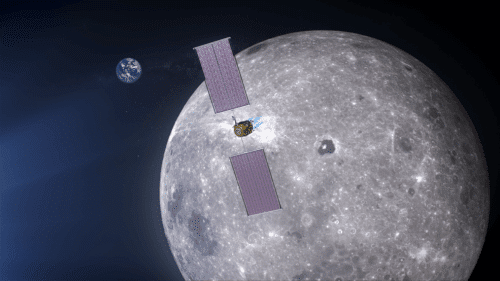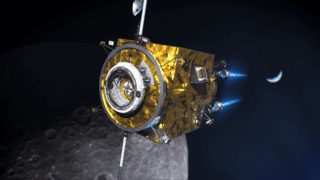The NASA director presented the details of the Artemis program, to launch an astronaut and an astronaut to the moon in 2024 * NASA chose the Maxar company (formerly SSL) to develop components for the "Moon Gate"

During his lecture yesterday (Thursday) by NASA Administrator Jim Bridenstine about over thirty launches expected in the next decade between in preparation for a manned landing on the moon in the Artemis program, he dwelled a lot on a new component that will replace the functions of the Apollo command module, but it will be permanent and will not be re-launched in every flight - building a satellite to the moon from which the landers will leave and descend to its surface. This is the moon gate. Maxar will receive an amount of 375 million dollars for this task.
In his words, Brandenstein emphasized that it is not about building an international space station around the moon, but rather something much more modest that could be used as a starting point for lunar landings, either by NASA, by other space agencies or private companies. As a theoretical example, Brandstein gave the possibility that a billionaire would build moon landings and establish a company that would exploit the moon's resources (which is allowed by a law recently passed in the USA according to which the discovery belongs to the discoverer on the moon as well).
In the first phase, the gate will focus on the minimum requirements to be used for the landing, and the first components will also be the infrastructure for the construction of phase 2, which will provide a strategic presence around the moon and a collection point for astronauts who will return from the moon. Establishing a manned control center around the moon will give the US a strategic advantage, according to him.
The gate will also be a building block for expanding manned capabilities on and around the moon.

"The power and propulsion component is the foundation of the gateway and a beautiful example of how NASA's partnerships with legacy and New Space companies can help accelerate the return of a crew to the Moon by 2024," Bridenstine said. "This will be the main component on which we will build the gateway, the cornerstone of NASA's reusable and sustainable Artemis architecture in lunar exploration and orbiting."
Maxer's task will not be easy, it will be required to supply 50 kilowatts of solar electricity to the electric propulsion system, 3 times more powerful than the current capabilities. The gate will also serve as a communications relay for human and robotic missions to the surface of the moon, with the first mission to the South Pole.
The design of the spacecraft will be completed within the next year and then development, launch and demonstration experiments will be carried out for a year in space during which the spacecraft will be fully owned and operated by Maxar. If the spacecraft is successful, NASA will be able to purchase the spacecraft that will serve as the first component of the gate.
Expansion on the other components of the Artemis program, below

4 תגובות
First, reasoning such as "Dahhhhhh!!!!" It is not a scientific reasoning but only indicates that the user is probably suffering from mild stupidity.
Second, you should always read to the end: I wrote that a very simple calculation shows that mining a large body like the moon changes its mass in a completely negligible way; In fact, an opposite (but equally stupid) argument - which is also completely negligible - can claim that the mass of the Moon (and the mass of the Earth) has been increasing in the last 4.5 billion years due to the incessant bombardment of interplanetary matter (such as asteroids and comets) In an estimated amount of at least tens of billions of tons every year - so how is it that the moon does not collide with the earth? After all, this mass, which is added to the system as doa + moon, is much greater than all the amounts of minerals that will be known and taken from the moon for hundreds of years; So how do you explain that the moon hasn't crashed into the earth yet?
The answer to this is the same answer I gave earlier: everything is relative!!! You just haven't internalized how huge the moon is. Such mass changes are completely negligible!, despite the mass additions to the moon and the like for billions of years - the moon is still on a trajectory that actually gets further and further away from the earth!
That concludes my arguments.
parable.
But the mass multiplier will change if material is transferred...
Dhahahahahaha!!!!
1. Forgive me for a blunt response and for slaughtering this sacred cow, but NASA also has quite a few puns: in the second paragraph it is stated that:
"... in his words, Brandenstein emphasized that it is not about building an international space station around the moon, but something much more modest that could be used as an exit point for lunar landings..." - but, gentlemen, this is exactly the definition and meaning of a space station!!! ?
2. For the comment of the "anonymous user": you should learn simple physics before you make fun of yourself: the two basic laws of physics of: a.) the principle of conservation of mass and b.) the fact that the force of attraction between two bodies depends solely on the distance between them and the product of their masses - After all, there will be no change in the movement of the moon around Earth even if material is transferred between them!
Furthermore, even if all the mining of minerals (metals and inorganic materials) takes place exclusively on the moon for the next hundreds of years, and all the minerals that come out of the moon are transferred to external places (even outside our solar system) - then this is a completely negligible change in the mass of the moon (try to calculate Do it yourself and you will get that the mass of the moon is millions of orders of magnitude greater than anything that will be taken from it) and therefore this too will not affect the movement of the moon around Earth!!!
Finally, according to precise measurements conducted since the sixties of the last century, it turns out that the moon is currently moving away from the earth at a rate of about 2.5 cm in each of our calendar years; In fact, the distance of the moon from Earth during its creation was about 25% of its distance today!
That means whether you like it or not - the moon will still "run away" from its orbit around Earth in the future, even if you don't change anything about it.
Transferring resources from the moon to the earth will cause a change in the mass of the moon and the dynamics of gravity, disaster!